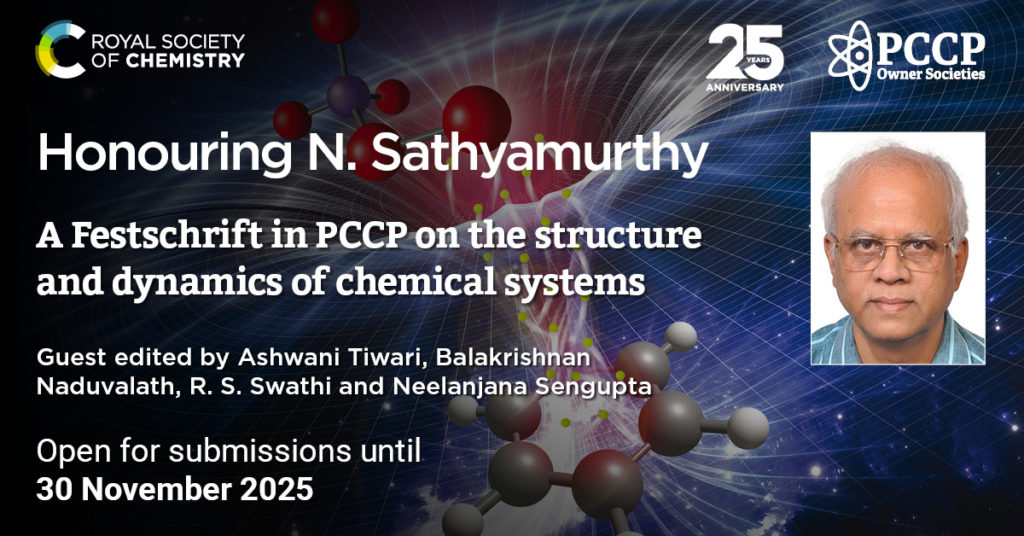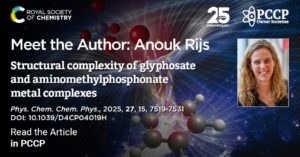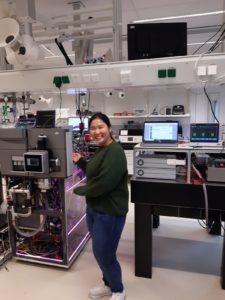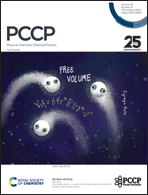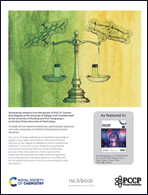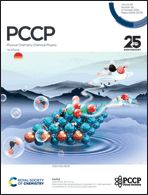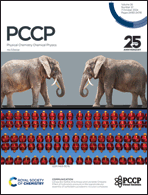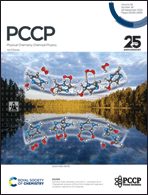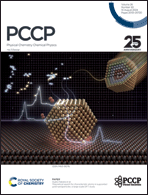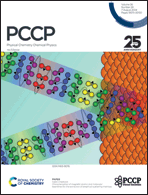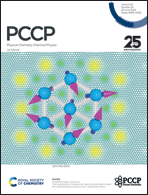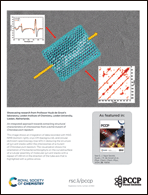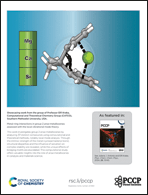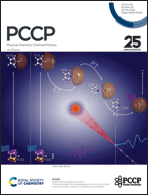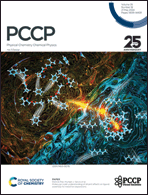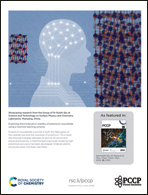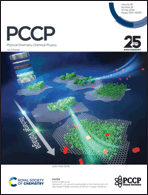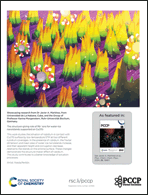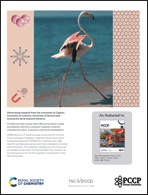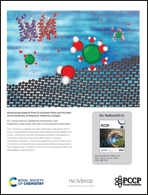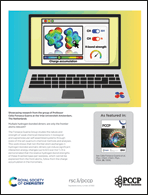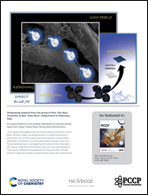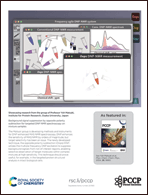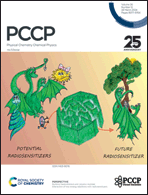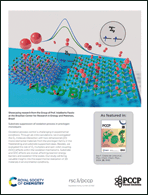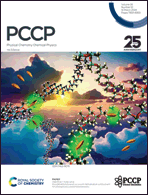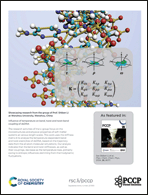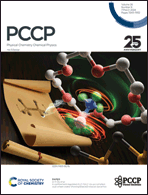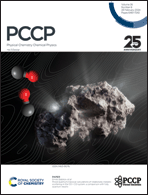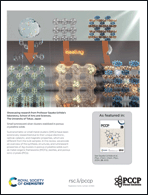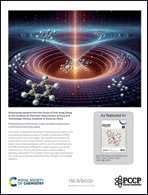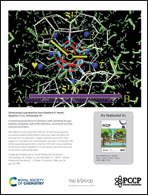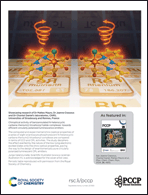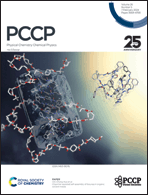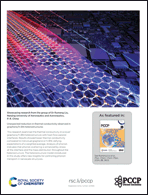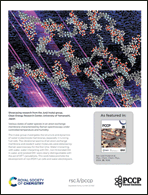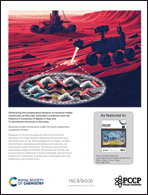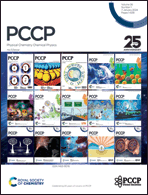 |
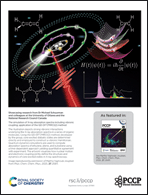 |
||
| Radiation damage to amino acids, peptides and DNA-binding proteins: the influence of water directly monitored by X-ray photoelectron spectroscopy
Dorothea C. Hallier, Jörg Radnik, Paul M. Dietrich, Harald Seitz and Marc Benjamin Hahn Phys. Chem. Chem. Phys., 2025, 27, 25789 DOI:10.1039/D5CP01887K |
The simulation of X-ray absorption spectra including vibronic coupling: application of the QD-DFT/MRCI(2) method
Martha Yaghoubi Jouybari, Simon P. Neville and Michael S. Schuurman Phys. Chem. Chem. Phys., 2025, 27, 25811 DOI:10.1039/D5CP02832A |
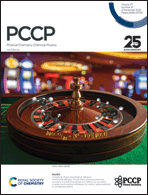 |
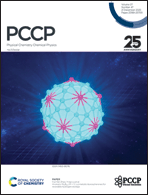 |
 |
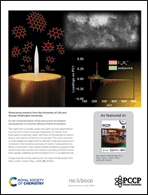 |
| Fixed node-diffusion Monte Carlo achieves chemical accuracy in predicting substituent effects on activation energies and reaction enthalpies for methyl radical addition to substituted olefins
Timothy B. Huber and Ralph A. Wheeler Phys. Chem. Chem. Phys., 2025, 27, 25282 DOI:10.1039/D5CP02300A |
Aromatic M12B60 (M = Y, Lu) metallo-borospherenes for reversible hydrogen storage
Yi-Sha Chen, Jing-Jing Guo, Peng-Bo Liu, Hui-Yan Zhao, Jing Wang and Ying Liu Phys. Chem. Chem. Phys., 2025, 27, 25292 DOI:10.1039/D5CP03352G |
Towards quantitative prediction of proton chemical shifts in imidazolium chloride ionic liquids by computational NMR
Ruijian Zhu, Tianying Yan, Yanting Wang and Giacomo Saielli Phys. Chem. Chem. Phys., 2025, 27, 25310 DOI:10.1039/D5CP03322E |
Ex situ characterization of the precursors of incipient nanoparticles in a laminar diffusion flame of ethylene
Harsh Chaliyawala, Erin McCaughey, Xavier Mercier, J. Houston Miller, Myriam Moreau, Nicolas Nuns, Pardis Simon and Alessandro Faccinetto Phys. Chem. Chem. Phys., 2025, 27, 25300 DOI:10.1039/D5CP02594J |
 |
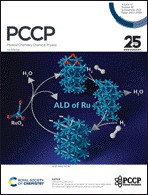 |
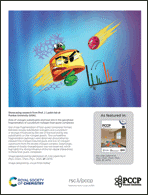 |
|
| The role of electron spin in molecular photochemical and photophysical processes: theory and experiment
Shirin Faraji, Martin Kleinschmidt, Bernd Engels and Andreas Dreuw Phys. Chem. Chem. Phys., 2025, 27, 24686 DOI:10.1039/D5CP90190A |
Finding the temperature window for atomic layer deposition of ruthenium metal via efficient phonon calculations
Alexandr Fonari, Simon D. Elliott, Casey N. Brock, Yan Li, Jacob Gavartin and Mathew D. Halls Phys. Chem. Chem. Phys., 2025, 27, 24704 DOI:10.1039/D5CP02945G |
Role of viologen substituents and host size in the gas-phase fragmentation of cucurbituril–viologen host–guest complexes
Hugo Y. Samayoa-Oviedo, Daniel M. Hristov, Bethany A. Phillips and Julia Laskin Phys. Chem. Chem. Phys., 2025, 27, 24713 DOI:10.1039/D5CP03029C |
 |
 |
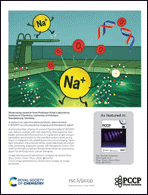 |
|
| Statistical vs. direct dissociation of molecular dications
Vaibhav Singh, Kovi Bodek, Gönenç Moğol, Chuan Cheng, Carlos A. Trallero-Herrero, Thomas Weinacht and Spiridoula Matsika Phys. Chem. Chem. Phys., 2025, 27, 24159 DOI:10.1039/D5CP02269J |
Magnetic interactions as a pivotal determinant in stabilizing a novel AgIIAgIIIF5 polymorph with high-spin AgIII
Daniel Jezierski, Paolo Barone and Wojciech Grochala Phys. Chem. Chem. Phys., 2025, 27, 24167 DOI:10.1039/D5CP02086G |
A sodium ion-selective photosensitizer: dibrominated F-BODIPY as a fluorescence imaging and therapeutic agent
Thomas Schwarze, Mazen Al Akrami, Julian Heinrich, Vinja Hergl, Eric Sperlich, Alexandra Kelling, Tobias Sprenger, Nicolas Jahn, Tillmann Klamroth and Nora Kulak Phys. Chem. Chem. Phys., 2025, 27, 24178 DOI:10.1039/D5CP03172A |
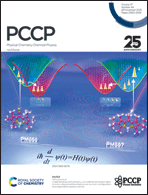 |
 |
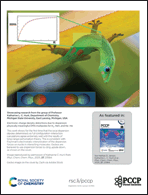 |
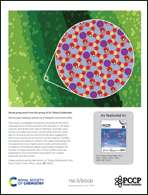 |
| Understanding contrasting S2 → S1 internal conversion rates in boron-dipyrromethene derivatives via multi-configuration time-dependent hartree method
Neethu Anand, Munnyon Kim, Changmin Lee, Jinhyuk Ma and Taiha Joo Phys. Chem. Chem. Phys., 2025, 27, 23550 DOI:10.1039/D5CP02771C |
Carbon support curvature modulates CO2 activation on molybdenum carbide clusters
Wei Cao, Francesc Viñes and Francesc Illas Phys. Chem. Chem. Phys., 2025, 27, 23561 DOI:10.1039/D5CP02714D |
Electronic charge density distortions due to dispersion: physically meaningful DMA multipoles for H2, HeH, and He⋯He
Nathan D. Jansen, Hua-Kuang Lee and Katharine L. C. Hunt Phys. Chem. Chem. Phys., 2025, 27, 23584 DOI:10.1039/D5CP01955A |
Nanoscopic feldspar islands on K-feldspar microcline (001)
Tobias Dickbreder, Franziska Sabath, Florian Schneider, Uwe Güth, Ralf Bechstein and Angelika Kühnle Phys. Chem. Chem. Phys., 2025, 27, 23574 DOI:10.1039/D5CP00610D |
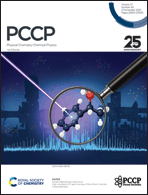 |
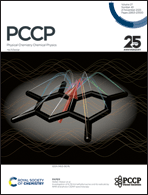 |
 |
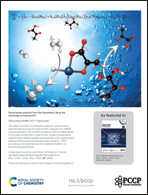 |
| High-resolution UV spectroscopy of the chiral molecule 1-phenylethanol
Shilpa Yadav, JuHyeon Lee, Gerard Meijer and Sandra Eibenberger-Arias Phys. Chem. Chem. Phys., 2025, 27, 22906 DOI:10.1039/D5CP02854J |
Investigation of 6,7,8-trimethyllumazine and its radicals by NMR and photo-CIDNP spectroscopy
Sabrina Panter, Boris Illarionov, Jing Chen, Adelbert Bacher, Markus Fischer and Stefan Weber Phys. Chem. Chem. Phys., 2025, 27, 22911 DOI:10.1039/D5CP02105G |
Multiconfigurational electronic structure calculations explain the role of ligands in g-tensor anisotropy for RuIII complexes
Pavel Pokhilko and Yulia Pushkar Phys. Chem. Chem. Phys., 2025, 27, 22937 DOI:10.1039/D5CP03298A |
(De)coding SABRE of [1-13C]pyruvate
Salvatore Mamone, Federico Floreani, Ahmed Mohammed Faramawy, Claudia Graiff, Lorenzo Franco, Marco Ruzzi, Cristina Tubaro and Gabriele Stevanato Phys. Chem. Chem. Phys., 2025, 27, 22924 DOI:10.1039/D5CP01773D |
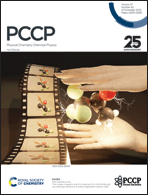 |
 |
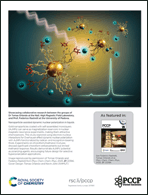 |
|
| The nuclear magneto-electric response of a chiral molecule via molecular dynamics in a time-dependent electric field
Mateusz A. Słowiński, Juha Vaara and Piotr Garbacz Phys. Chem. Chem. Phys., 2025, 27, 22343 DOI:10.1039/D5CP02294K |
Accelerating drug discovery for Disease X via an AlphaFold2 driven drug repositioning strategy
Huixuan Zhao, Wentao Qi, Ke Liu, Jiayi Zhao, Xueping Hu and Weiqiao Deng Phys. Chem. Chem. Phys., 2025, 27, 22354 DOI:10.1039/D5CP01365H |
Nanoparticle-assisted dynamic nuclear polarization in liquids
Beatrice Bernadette Mascitti, Giordano Zanoni, Alex van der Ham, Luming Yang, Lorenzo Franco, Fabrizio Mancin, Federico Rastrelli and Tomas Orlando Phys. Chem. Chem. Phys., 2025, 27, 22366 DOI:10.1039/D5CP02465J |
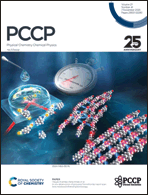 |
 |
||
| In situ observation of polyurea formation by rapid-scan time-resolved infrared spectroscopy
Yasuko Koshiba, Satoshi Atsumi, Tatsuya Fukushima, Shohei Horike and Kenji Ishida Phys. Chem. Chem. Phys., 2025, 27, 21871 DOI:10.1039/D5CP02518D |
Electron stopping power of α-particles in silicon regulated by ultrashort pulse lasers
Ya-Ting Sun, Xiao-Ning Yang, Xin Shen, Feng Wang and Lan Jiang Phys. Chem. Chem. Phys., 2025, 27, 21878 DOI:10.1039/D5CP03149D |
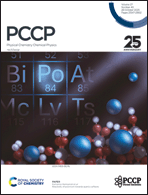 |
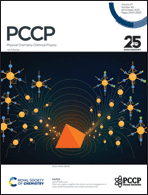 |
||
| Reactivity of polonium towards quartz surfaces
Katharina Hermainski, Alexander Yakushev, Dominik Dietzel, Christoph Emanuel Düllmann, Jochen Ballof, Pavol Mošat’, Felix Sprunk, Pavel Bartl, Jan John, Jörg Krier, Mojmír Němec, Jon Petter Omtvedt and Jan Štursa Phys. Chem. Chem. Phys., 2025, 27, 21414 DOI:10.1039/D5CP02381E |
First-principles insights into structure and magnetism in ultra-small tetrahedral iron oxide nanoparticles
Valentína Berecová, Martin Friák, Naděžda Pizúrová and Jana Pavlů Phys. Chem. Chem. Phys., 2025, 27, 21424 DOI:10.1039/D5CP01415H |
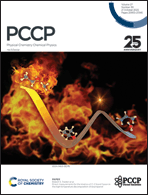 |
 |
 |
|
| Direct measurements for the kinetics of C–C bond fission in the high temperature decomposition of isopropanol
John H. Kim, Keunsoo Kim, Sebastian L. Peukert, Joe V. Michael, Raghu Sivaramakrishnan, Margaret S. Wooldridge and Robert S. Tranter Phys. Chem. Chem. Phys., 2025, 27, 20983 DOI:10.1039/D5CP02482J |
A systematic study of oxide passivation induced by chemical composition and microstructure regulation in high entropy alloys
Jianqiao Yu, Panhua Shi, Yiying Yang, Rongchuan Li, Jiaxuan Si, Fan Yang and Yuexia Wang Phys. Chem. Chem. Phys., 2025, 27, 21009 DOI:10.1039/D5CP02698A |
Novel chalcogen and halogen surface functional groups for tuning the mechanical properties of TMDs/MXenes heterojunctions
Yuqian Zhang, Zhiwei Liu, Siyu Zheng, Changyang Yu, Siliang Yue, Chenliang Li and Hui Qi Phys. Chem. Chem. Phys., 2025, 27, 20994 DOI:10.1039/D5CP01389E |
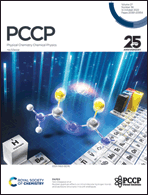 |
|||
| Nuclear quantum effects on intramolecular hydrogen bonds and backbone structures in biuret analogues
Kotomi Nishikawa, Hikaru Tanaka, Kazuaki Kuwahata, Masanori Tachikawa and Taro Udagawa Phys. Chem. Chem. Phys., 2025, 27, 20474 DOI:10.1039/D5CP02587G |
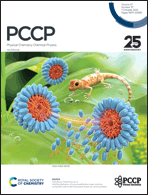 |
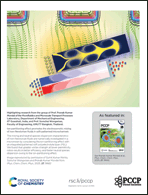 |
 |
|
| Wetting behavior of polyoxyethylene-type nonionic surfactant with multi-branched chains on solid surfaces
Risa Kawai, Nana Tsutsui, Kotoha Ueno, Shiho Yada, Masashi Ohno, Toshinari Koda and Tomokazu Yoshimura Phys. Chem. Chem. Phys., 2025, 27, 19642 DOI:10.1039/D5CP02321A |
Ion-partitioning effect promotes the electroosmotic mixing of non-Newtonian fluids in soft-patterned microchannels
Sumit Kumar Mehta, Prateechee Padma Behera, Abhishek Dutta, Bhashkar Jyoti Sharma, Anubhab Gaurav Borah, Pragyan Bora, Subhrajit Borah, Somchai Wongwises and Pranab Kumar Mondal Phys. Chem. Chem. Phys., 2025, 27, 19662 DOI:10.1039/D5CP02072G |
Light-induced electron spin qubit coherences in the purple bacteria reaction center protein
Jasleen K. Bindra, Jens Niklas, Yeonjun Jeong, Ahren W. Jasper, Lisa M. Utschig and Oleg G. Poluektov Phys. Chem. Chem. Phys., 2025, 27, 19651 DOI:10.1039/D4CP03971H |
 |
|||
| The euroSAMPL1 pKa blind prediction and reproducible research data management challenge
Nicolas Tielker, Michel Lim, Patrick Kibies, Juliana Gretz, Björn Hein-Janke, Christian Chodun, Ricardo A. Mata, Paul Czodrowski and Stefan M. Kast Phys. Chem. Chem. Phys., 2025, 27, 18855 DOI:10.1039/D5CP01448D |
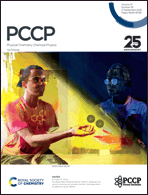 |
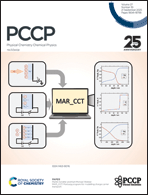 |
||
| Excited-state antiaromaticity relief in photoactive amine–boranes promotes transfer hydrogenation to electron-poor olefins
Enrique M. Arpa Phys. Chem. Chem. Phys., 2025, 27, 18121 DOI:10.1039/D5CP02226F |
MAR_CCT: Marburg program for modelling charge carrier transport
Martin Schäfer and Karl-Michael Weitzel Phys. Chem. Chem. Phys., 2025, 27, 18128 DOI:10.1039/D5CP01926E |
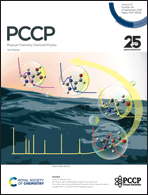 |
 |
||
| pH-Dependent absorption spectra of aqueous 4-imidazolecarboxaldehyde: theoretical and experimental insights into a marine chromophore proxy
Lily J. Watson, Elizabeth Scholer, Caroline H. V. Calvert and Juan G. Navea Phys. Chem. Chem. Phys., 2025, 27, 17673 DOI:10.1039/D5CP01553G |
Conformer specific photophysical properties of an analog of the green fluorescent protein chromophore anion
A. G. S. Lauridsen, A. P. Rasmussen, N. Klinkby and L. H. Andersen Phys. Chem. Chem. Phys., 2025, 27, 17686 DOI:10.1039/D5CP02407B |
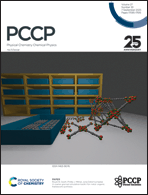 |
 |
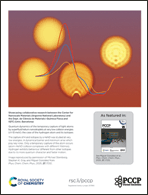 |
|
| A coarse-grained simulation toolkit for metal–organic framework synthesis
Reum N. Scott, Phillip J. Milner and Julia Dshemuchadse Phys. Chem. Chem. Phys., 2025, 27, 17183 DOI:10.1039/D5CP02121A |
Harnessing electrochemical CO2 reduction and assisted water electrolysis via constrained thermodynamic modeling
Jinuk Choi, Hyojung Lim, Subramani Surendran, Seonghyeon Park, Junho Shim, Gyoung Hwa Jeong and Uk Sim Phys. Chem. Chem. Phys., 2025, 27, 17198 DOI:10.1039/D5CP01408E |
Quantum dynamics of the temporary capture of light atoms by superfluid helium nanodroplets at very low collision energies (≈1–13 meV): the case of the hydrogen atom and its isotopes
Michael Sternberg, Stephen K. Gray and Miguel González Phys. Chem. Chem. Phys., 2025, 27, 17212 DOI:10.1039/D5CP01498K |
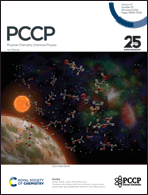 |
 |
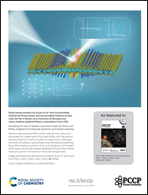 |
|
| Temperature-driven reaction pathways of gas-phase protonated glycolaldehyde formation and dissociation
Weiqi Wang, Xiangyue Liu and Jesús Pérez-Ríos Phys. Chem. Chem. Phys., 2025, 27, 16744 DOI:10.1039/D5CP01732G |
Carbon nanotube film electrodes enabled by nanostructured biopolymers through aqueous processing
Carlos Martínez-Barón, Víctor Calvo, Miguel Ángel Álvarez-Sánchez, F. Javier Pascual, Wolfgang K. Maser, Ana M. Benito, Alejandro Ansón-Casaos and José Miguel González-Domínguez Phys. Chem. Chem. Phys., 2025, 27, 16756 DOI:10.1039/D5CP01536G |
Revealing the role of ripples in phonon modes for MoS2 and MoSe2: insights from molecular dynamics and machine learning
Gabriel Bruno G. de Souza, Steven B. Hancock, David Paul Landau, Yohannes Abate, Rosângela de Paiva and Von Braun Nascimento Phys. Chem. Chem. Phys., 2025, 27, 16768 DOI:10.1039/D5CP00163C |
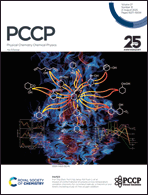 |
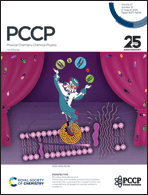 |
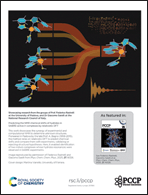 |
|
| Impact of conformational structures on low-temperature oxidation chemistry for cyclohexyl radicals: a theoretical and kinetic modeling study on first oxygen addition
Hui-Ting Bian, Yang Wang, Shi-Hao Feng, Long Zhao, Wen-Chao Lu, Hui-Ling Jiang and Kai-Yuan Li Phys. Chem. Chem. Phys., 2025, 27, 16311 DOI:10.1039/D5CP01550B |
Harnessing antimicrobial peptide-functionalized nanoparticles: a perspective on experimental and computational strategies to combat antibiotic resistance
Miroslava Nedyalkova, Diana Potes Vecini, Andrew S. Paluch and Marco Lattuada Phys. Chem. Chem. Phys., 2025, 27, 16284 DOI:10.1039/D5CP01880C |
Predicting the NMR chemical shifts of hydrides in SABRE-active Ir complexes by relativistic DFT
Beatrice Bernadette Mascitti, Giordano Zanoni, Federico de Biasi, Federico Rastrelli and Giacomo Saielli Phys. Chem. Chem. Phys., 2025, 27, 16326 DOI:10.1039/D5CP01214G |
 |
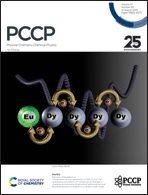 |
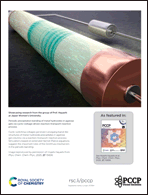 |
|
| Ion exchange: an essential piece in the fabrication of zeolite adsorbents
Chenxin Li, Tiesen Li, Qingyan Cui, Tinghai Wang, Chan Wang, Jiao Yang, Jie Shi, Xiaojun Bao and Yuanyuan Yue Phys. Chem. Chem. Phys., 2025, 27, 15819 DOI:10.1039/D5CP00894H |
Visualization of trap distribution in SrAl2O4:Eu2+,Dy3+ revealed by simulations of luminescence changes in charging and emission of persistent luminescence and thermoluminescence based on a random walk model
Ryusuke Koizumi, Ryoya Takahashi, Shigeki Yamada, Shingo Hattori and Kazuteru Shinozaki Phys. Chem. Chem. Phys., 2025, 27, 15850 DOI:10.1039/D5CP01232E |
Periodic precipitation banding of metal hydroxides in agarose gels via cyclic-voltage-driven reaction–transport–reaction process
Hisashi Hayashi, Rina Arifuku, Kaho Yamada, Misato Nampo, Kana Ogitani and Toyohiko Aiki Phys. Chem. Chem. Phys., 2025, 27, 15858 DOI:10.1039/D5CP01515D |
 |
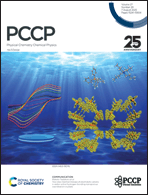 |
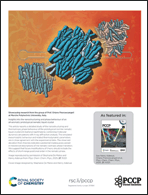 |
|
| Probing photoreactions of individual suspended carbonaceous aerosols by multi-wavelength OT-SERS
Hang Zhong, Jun Chen, Yi Hu, Jun Chen, Tao Shao and Junsheng Liao Phys. Chem. Chem. Phys., 2025, 27, 15314 DOI:10.1039/D5CP01319D |
Two-step insertion/release of electrolytic cations in redox-active hydrogen-bonding nanoporous coordination crystals
Makoto Tadokoro, Ryota Nishimura, Hajime Kamebuchi, Fumiya Kobayashi, Jun Miyazaki and Masa-aki Haga Phys. Chem. Chem. Phys., 2025, 27, 15310 DOI:10.1039/D5CP01130B |
Insights into the nanostructuring and phase behaviour of an all-aromatic prototypical nematic liquid crystal
Henry Adenusi, Luca Muccioli, Matteo Lanciotti, Maruti Hegde, Theo J. Dingemans, Edward T. Samulski, Francesco Vita and Oriano Francescangeli Phys. Chem. Chem. Phys., 2025, 27, 15321 DOI:10.1039/D5CP01423A |
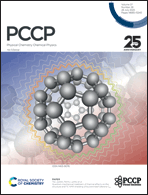 |
 |
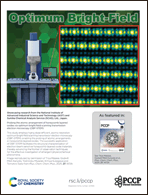 |
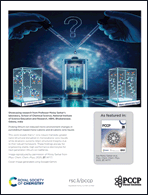 |
| Quantum-mechanical treatment of thermal effects on the structure and 13C NMR shielding of buckminsterfullerene C60
Tiia Jacklin, Petr Štěpánek and Perttu Lantto Phys. Chem. Chem. Phys., 2025, 27, 14759 DOI:10.1039/D5CP01484K |
Structural stability of chromophore-grafted Ubiquitin mutants in vacuum
Emiliano De Santis, Thomas Mandl, Jocky C. K. Kung, Khon Huynh, Steven Daly, Lorenza A. D’Alessandro, Luke MacAleese, Charlotte Uetrecht, Erik G. Marklund and Carl Caleman Phys. Chem. Chem. Phys., 2025, 27, 14767 DOI:10.1039/D5CP01297J |
Probing the atomic arrangement of honeycomb layered oxides via optimum bright-field scanning transmission electron microscopy (OBF-STEM)
Titus Masese, Godwill Mbiti Kanyolo, Yoshinobu Miyazaki, Kimiya Sukegawa and Tomohiro Saito Phys. Chem. Chem. Phys., 2025, 27, 14729 DOI:10.1039/D5CP01190F |
Probing lithium-ion induced micro-environment changes in pyrrolidinium-based mono-cationic and di-cationic ionic liquids
Amita Mahapatra, Unmesh D. Chowdhury, Subahakanta Parida, Sahadev Barik, Joyoti Ghosh, B. L. Bhargava and Moloy Sarkar Phys. Chem. Chem. Phys., 2025, 27, 14777 DOI:10.1039/D5CP00365B |
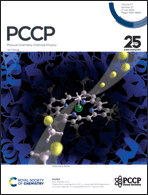 |
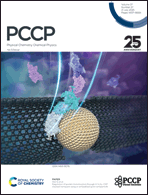 |
||
| Theoretical investigation of F430-catalyzed dehalogenation of chloro-alkanes. A comprehensive DFT benchmark
Dominik Dusza, Mateusz Pokora, Li Ji and Piotr Paneth Phys. Chem. Chem. Phys., 2025, 27, 14217 DOI:10.1039/D4CP04500A |
Regulation of protein translocation through A Si3N4-CNT stacked nanopore using an embedded gold nanoparticle
Wei Si, Haonan Chen and Gensheng Wu Phys. Chem. Chem. Phys., 2025, 27, 14229 DOI:10.1039/D5CP01017A |
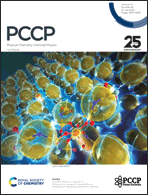 |
 |
||
| Enhanced ion-transport characteristics of pyrrolidinium-based electrolytes with Mg(FSA)2
Yoshifumi Hirotsu, Mizuki Kimura, Shinkoh Nanbu, Yuko Takeoka, Masahiro Rikukawa and Masahiro Yoshizawa-Fujita Phys. Chem. Chem. Phys., 2025, 27, 13826 DOI:10.1039/D5CP01386K |
Correlating reductive vanadium oxide transformations with electrochemical N2 activation and ammonia formation
Kabirat Balogun, Qasim Adesope, Stella Amagbor, Agbara Tochi, Adam Vass, Guido Mul, Christoph Baeumer, Georgios Katsoukis and Jeffry A. Kelber Phys. Chem. Chem. Phys., 2025, 27, 13836 DOI:10.1039/D5CP00554J |
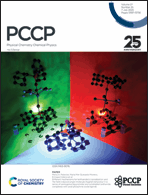 |
 |
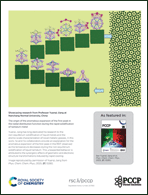 |
|
| Different mechanisms for lanthanide(III) sensitization and Yb-field-induced single-molecule magnet behaviour in a series of pentagonal bipyramidal and octahedral lanthanide complexes with axial phosphine oxide ligands
Hadjer Allia, Ana Rodríguez-Expósito, María A. Palacios, Juan-Ramón Jiménez, Albano N. Carneiro Neto, Renaldo T. Moura, Fabio Piccinelli, Amparo Navarro, María Mar Quesada-Moreno and Enrique Colacio Phys. Chem. Chem. Phys., 2025, 27, 13266 DOI:10.1039/D4CP04862H |
X-ray spectroscopy meets native mass spectrometry: probing gas-phase protein complexes
Jocky C. K. Kung, Alan Kádek, Knut Kölbel, Steffi Bandelow, Sadia Bari, Jens Buck, Carl Caleman, Jan Commandeur, Tomislav Damjanović, Simon Dörner, Karim Fahmy, Lara Flacht, Johannes Heidemann, Khon Huynh, Janine-Denise Kopicki, Boris Krichel, Julia Lockhauserbäumer, Kristina Lorenzen, Yinfei Lu, Ronja Pogan, Jasmin Rehmann, Kira Schamoni-Kast, Lucas Schwob, Lutz Schweikhard, Sebastian Springer, Pamela H. W. Svensson, Florian Simke, Florian Trinter, Sven Toleikis, Thomas Kierspel and Charlotte Uetrecht Phys. Chem. Chem. Phys., 2025, 27, 13234 DOI:10.1039/D5CP00604J |
The origin of the anomalous expansion of the first peak in the radial distribution function during the rapid solidification of tantalum metal
Yuanqi Jiang, Dadong Wen, Qiang Xu, Jian Lv, Rui Zhao and Ping Peng Phys. Chem. Chem. Phys., 2025, 27, 13280 DOI:10.1039/D5CP00247H |
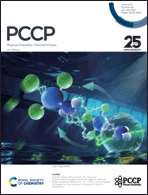 |
 |
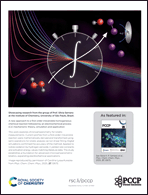 |
|
| Exploring the trans effect of the NH3 ligand in platinum halide complexes Pt(NH3)ClX2− (X = Cl, Br, I) using cryogenic photoelectron spectroscopy and quantum chemical calculations
Qixu Zhao, Jian Zhang, Xueying Li, Peng Tang, Fan Yang, Junyang Ma, Zhubin Hu, Haitao Sun, Xue-Bin Wang, Zhenrong Sun and Yan Yang Phys. Chem. Chem. Phys., 2025, 27, 12657 DOI:10.1039/D5CP00807G |
Vetting molecular candidates posited for the first diffuse interstellar bands (5780 and 5797 Å): a quantum chemical study
Halis Seuret, Ailish D. Sullivan, Cercis Morera-Boado, Tina A. Harriott, Daniel Majaess, Lou Massa and Chérif F. Matta Phys. Chem. Chem. Phys., 2025, 27, 12666 DOI:10.1039/D4CP04023F |
A new approach to a first order irreversible homogeneous chemical reaction followed by an electrochemical process (CiE mechanism): theory, simulation and application
Rafael A. L. Chioquetti, Raphael P. Bacil and Silvia H. P. Serrano Phys. Chem. Chem. Phys., 2025, 27, 12675 DOI:10.1039/D4CP04092A |
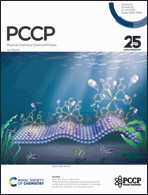 |
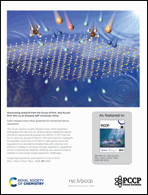 |
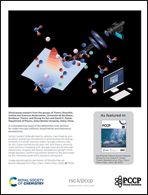 |
|
| Effect of anchoring groups on the photocatalytic performance of iridium(III) complexes in hydrogen production and their toxicological analysis
Xiao Yao, Linyu Fan, Zhuwu Jiang, Chaoqun Zheng, Jinfeng Chen, Yachen Jiang, Yisang Lu, Cheuk-Lam Ho and Yuanmei Chen Phys. Chem. Chem. Phys., 2025, 27, 12129 DOI:10.1039/D4CP04828H |
Sulfur-doped crown ether graphane for enhanced helium separation
Qinglan Zhao, Yingying Fu, Xiaxia Gong, Wenming Lu, Lin Dai, Wei Liu and Jing Xu Phys. Chem. Chem. Phys., 2025, 27, 12152 DOI:10.1039/D5CP00957J |
A comprehensive study of the differential cross sections for water–rare gas collisions: experimental and theoretical perspectives
Ricardo Manuel García-Vázquez, Zhong-Fa Sun, Chung-Hsin Yang, Lisán David Cabrera-González, Otoniel Denis-Alpizar, Philippe Halvick, David H. Parker and Thierry Stoecklin Phys. Chem. Chem. Phys., 2025, 27, 12139 DOI:10.1039/D4CP04825C |
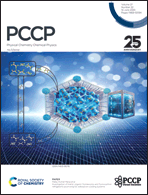 |
 |
||
| Investigation of metal–organic frameworks and fluorocarbon refrigerants promising for adsorption cooling systems
Dipankar Singha, Debansh Mohapatra and Malay Kumar Rana Phys. Chem. Chem. Phys., 2025, 27, 11530 DOI:10.1039/D4CP04816D |
Electronic and optical properties in helical trilayer graphene under compression
Ossiel Aguilar-Spíndola, Alberto Rubio-Ponce, Florentino López-Urías and Francisco Sánchez-Ochoa Phys. Chem. Chem. Phys., 2025, 27, 11541 DOI:10.1039/D5CP00337G |
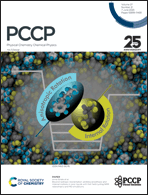 |
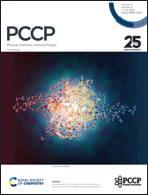 |
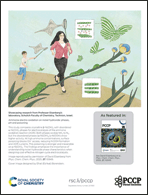 |
|
| Beyond isotropic reorientation: probing anisotropic and internal motions in ionic liquids with fast field cycling NMR relaxometry and MD simulations
Lennart Kruse, Tanja van Alphen, Johanna Busch, Dietmar Paschek, Ralf Ludwig and Anne Strate Phys. Chem. Chem. Phys., 2025, 27, 10927 DOI:10.1039/D5CP00582E |
Dipole orientation of hydrated gas phase proteins
Harald Agelii, Ellen L. S. Jakobsson, Emiliano De Santis, Gideon Elfrink, Thomas Mandl, Erik G. Marklund and Carl Caleman Phys. Chem. Chem. Phys., 2025, 27, 10939 DOI:10.1039/D5CP00073D |
Ammonia electro-oxidation on nickel hydroxide: phases, pH and poisoning
Inbal Offen-Polak, Hilla Ayali Aviram, Adan Hijaze, Thierry K. Slot and David Eisenberg Phys. Chem. Chem. Phys., 2025, 27, 10949 DOI:10.1039/D4CP02950J |
 |
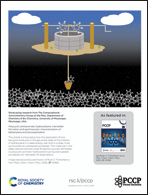 |
||
| Substituted acridones: simple deep blue HIGHrISC emitters in an aprotic environment
Matthias Jantz, David Klaverkamp, Lennart Bunnemann, Martin Kleinschmidt, Constantin Czekelius and Peter Gilch Phys. Chem. Chem. Phys., 2025, 27, 10444 DOI:10.1039/D4CP04781H |
Polycyclic (anti)aromatic hydrocarbons: interstellar formation and spectroscopic characterization of biphenylene and benzopentalene
Athena R. Flint, Vincent J. Esposito and Ryan C. Fortenberry Phys. Chem. Chem. Phys., 2025, 27, 10456 DOI:10.1039/D5CP00630A |
 |
 |
||
| Inferring networks of chemical reactions by curvature analysis of kinetic trajectories
Vignesh Narayanan, Lawrence K. Bordoh, István Z. Kiss and Jr-Shin Li Phys. Chem. Chem. Phys., 2025, 27, 9962 DOI:10.1039/D4CP04338C |
A non-metal doped VTe2 monolayer: theoretical insights into the enhanced mechanism for the hydrogen evolution reaction
Yanwei Wang, Guofeng Li, Jisong Hu, Ge Gao, Ying Zhang, Guangxia Shi, Xu Yang, Lei Zhang, Ling Fang and Yinwei Li Phys. Chem. Chem. Phys., 2025, 27, 9970 DOI:10.1039/D5CP00670H |
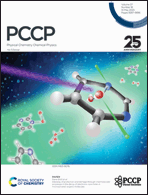 |
 |
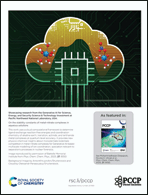 |
|
| Interplay of protection and damage through intermolecular processes in the decay of electronic core holes in microsolvated organic molecules
Dana Bloß, Nikolai V. Kryzhevoi, Jonas Maurmann, Philipp Schmidt, André Knie, Johannes H. Viehmann, Catmarna Küstner-Wetekam, Sascha Deinert, Gregor Hartmann, Florian Trinter, Lorenz S. Cederbaum, Arno Ehresmann, Alexander I. Kuleff and Andreas Hans Phys. Chem. Chem. Phys., 2025, 27, 9329 DOI:10.1039/D4CP03907F |
Decomposition of methanol activated by surface under-coordinated Pd on layered PdTe2
Jing-Wen Hsueh, Lai-Hsiang Kuo, Po-Han Chen, Wan-Hsin Chen, Chi-Yao Chuang, Chia-Nung Kuo, Chin-Shan Lue, Hung-Wei Shiu, Bo-Hong Liu, Chia-Hsin Wang, Yao-Jane Hsu, Chun-Liang Lin, Jyh-Pin Chou and Meng-Fan Luo Phys. Chem. Chem. Phys., 2025, 27, 9336 DOI:10.1039/D5CP00130G |
On the stability constants of metal–nitrate complexes in aqueous solutions
Mohammadhasan Dinpajooh, Greta L. Hightower, Richard E. Overstreet, Lori A. Metz, Neil J. Henson, Niranjan Govind, Andrew M. Ritzmann and Nicolas E. Uhnak Phys. Chem. Chem. Phys., 2025, 27, 9350 DOI:10.1039/D4CP04295F |
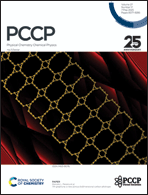 |
 |
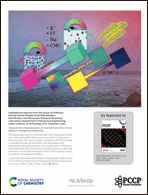 |
|
| TH-graphyne: a new porous bidimensional carbon allotrope
Kleuton A. L. Lima, Rodrigo A. F. Alves, Daniel A. da Silva, Fábio L. L. Mendonça, Marcelo L. Pereira and Luiz A. Ribeiro Phys. Chem. Chem. Phys., 2025, 27, 8684 DOI:10.1039/D4CP02923B |
Multidimensional quantum Fourier transform for nanosheet material evaluation by electron microscopy: a case of 2D pattern processing
Hiroshi Sampei, Tetsuya Mizuguchi, Koki Saegusa, Makoto Nakamura, Koichi Kimura and Yasushi Sekine Phys. Chem. Chem. Phys., 2025, 27, 8656 DOI:10.1039/D4CP04399E |
Towards the characterization of chemiosmotic flow of ionic liquids in charged nanochannels
Prasenjeet Padhi, Sumit Kumar Mehta, Pranab Kumar Mondal and Somchai Wongwises Phys. Chem. Chem. Phys., 2025, 27, 8692 DOI:10.1039/D5CP00555H |
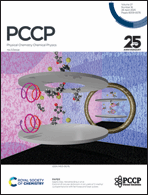 |
|||
| Control of circular dichroism in ion yield of 3-methyl cyclopentanone with femtosecond laser pulses
Sagnik Das, Jayanta Ghosh, Sudheendran Vasudevan, Simon T. Ranecky, Tonio Rosen, Nicolas Ladda, Han-gyeol Lee, Till-Jakob Stehling, Fabian Westmeier, Jochen Mikosch, Arne Senftleben, Thomas Baumert and Hendrike Braun Phys. Chem. Chem. Phys., 2025, 27, 8043 DOI:10.1039/D4CP04572F |
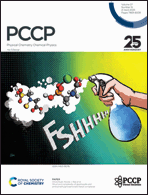 |
|||
| Structural complexity of glyphosate and aminomethylphosphonate metal complexes
Olivia Rusli, Oscar H. Lloyd Williams, Papri Chakraborty, Marco Neumaier, Frank Hennrich, Sjors Bakels, Kevin Hes, Anouk M. Rijs, Boris Ucur, Shane R. Ellis, River J. Pachulicz, Tara L. Pukala and Nicole J. Rijs Phys. Chem. Chem. Phys., 2025, 27, 7519 DOI:10.1039/D4CP04019H |
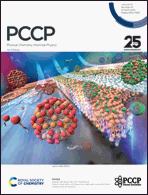 |
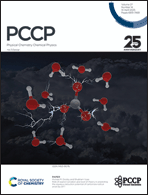 |
 |
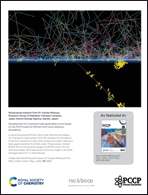 |
| Direct observation of interactions between supported lipid bilayers and surfactants
Masaki Hanzawa, Hiroaki Sugasawa, Taku Ogura, Ken-ichi Iimura and Takeshi Misono Phys. Chem. Chem. Phys., 2025, 27, 6858 DOI:10.1039/D4CP04449E |
Role of explicit solvation and level of theory in predicting the aqueous reduction potential of carbonate radical anion by DFT
Michael R. Dooley and Shubham Vyas Phys. Chem. Chem. Phys., 2025, 27, 6867 DOI:10.1039/D4CP04487H |
Self-powered photodetector of GaN/Sc2CCl2 heterojunction with high carrier mobility and polarization sensitivity
Guoqing Zhang, Zhen Cui, Aming Song, Shuang Zhang and Lu Wang Phys. Chem. Chem. Phys., 2025, 27, 6875 DOI:10.1039/D4CP04162C |
Development of a chemical code applicable to ions based on the PHITS code for efficient and visual radiolysis simulations
Yusuke Matsuya, Yuji Yoshii, Tamon Kusumoto, Tatsuhiko Ogawa, Seiki Ohnishi, Yuho Hirata, Tatsuhiko Sato and Takeshi Kai Phys. Chem. Chem. Phys., 2025, 27, 6887 DOI:10.1039/D4CP04216F |
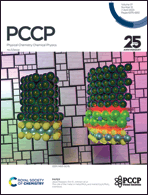 |
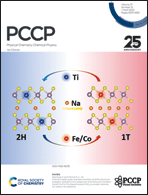 |
 |
|
| The role of the metal in metal/MoS2 and metal/Ca2N/MoS2 interfaces
Adrian F. Rumson, Mohammad Rafiee Diznab, Jesse Maassen and Erin R. Johnson Phys. Chem. Chem. Phys., 2025, 27, 6438 DOI:10.1039/D4CP04577G |
First-principles study of phase transition and the structural, energetic and electronic properties of pristine and transition metal (Fe/Co/Ti)-doped layered MoS2 as anode materials for sodium-ion batteries
Wenlong Xi and Patrick H.-L. Sit Phys. Chem. Chem. Phys., 2025, 27, 6447 DOI:10.1039/D5CP00286A |
Ultrathin liquid sheets: water gets in shape for VUV absorption
Jonas Knurr, Patrick Hemberger, Patrick Ascher, Sven Augustin, David J. Hoffman, Gregor Knopp, Samuel Menzi, Zhibin Sun, Simon Tiefenbacher, Reto Wetter, Jake D. Koralek, Antoine Sarracini, Kirsten Schnorr, Christoph Bostedt, Andras Bodi and Andre Al Haddad Phys. Chem. Chem. Phys., 2025, 27, 6457 DOI:10.1039/D4CP04619F |
 |
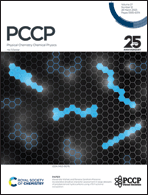 |
 |
|
| How the nitro group position determines the emission properties of π-expanded diketopyrrolopyrroles
Kamil Skonieczny, Francesco Di Maiolo, Sara Venturi, Alessandro Iagatti, Alessandro Ricci, Francesco Bertocchi, Daniel T. Gryko and Andrea Lapini Phys. Chem. Chem. Phys., 2025, 27, 5965 DOI:10.1039/D4CP04689G |
Accelerated diradical character assessment in large datasets of polybenzenoid hydrocarbons using xTB fractional occupation
Alexandra Wahab and Renana Gershoni-Poranne Phys. Chem. Chem. Phys., 2025, 27, 5973 DOI:10.1039/D4CP04059G |
Tunable elastic wave bandgaps by strain engineering of multilayered van der Waals metamaterials
Yabin Jing, Lifeng Wang and Eric Li Phys. Chem. Chem. Phys., 2025, 27, 5984 DOI:10.1039/D4CP03540B |
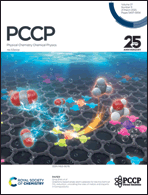 |
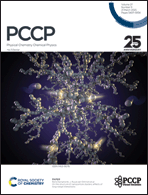 |
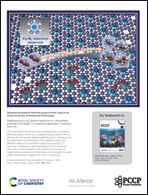 |
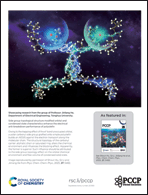 |
| Graphene-based single-atom catalysts for electrochemical CO2 reduction: unraveling the roles of metals and dopants in tuning activity
Colin Gallagher, Manish Kothakonda and Qing Zhao Phys. Chem. Chem. Phys., 2025, 27, 5464 DOI:10.1039/D4CP04212C |
On the structure of nanoparticle clusters: effects of long-range interactions
Rens Kamphorst, Maximilian F. Theisen, Ankur D. Bordoloi, Samir Salameh, Gabrie M. H. Meesters and J. Ruud van Ommen Phys. Chem. Chem. Phys., 2025, 27, 5476 DOI:10.1039/D4CP04235B |
Neighbouring Cu–B6 electron reservoirs in α-borophene promote long-range C–C coupling to generate C2 products from CO2
Hongguang Wang, Peiyao Bai, Yiming Ren, Shilin Wei and Lang Xu Phys. Chem. Chem. Phys., 2025, 27, 5494 DOI:10.1039/D4CP04618H |
Side group topological structure modified orbital and condensed state characteristics enhance the electrical anti-breakdown performance of polyolefin
Shixun Hu, Cheng Tong, Xiongjie Yang, Shangshi Huang, Jun Hu, Qi Li and Jinliang He Phys. Chem. Chem. Phys., 2025, 27, 5482 DOI:10.1039/D4CP03902E |
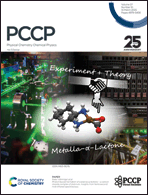 |
 |
||
| Photoinduced formation of a platina-α-lactone – a carbon dioxide complex of platinum. Insights from femtosecond mid-infrared spectroscopy
Markus Bauer, Raphaela Post, Luis I. Domenianni and Peter Vöhringer Phys. Chem. Chem. Phys., 2025, 27, 5012 DOI:10.1039/D4CP03840A |
Investigating Ni nanoparticles on CeO2 for methane dissociation: a comparative study of theoretical calculations and experimental insights
Takaya Fujisaki, Yuta Tsuji, Phuc Hoan Tu, Tin Chanh Duc Doan, David S. Rivera Rocabado, Aleksandar Tsekov Staykov, Keiji Yashiro and Yusuke Shiratori Phys. Chem. Chem. Phys., 2025, 27, 5024 DOI:10.1039/D4CP01324G |
 |
 |
||
| Structure factor line shape model gives approximate nanoscale size of polar aggregates in pyrrolidinium-based ionic liquids
Ralph A. Wheeler and Emily E. Dalbey Phys. Chem. Chem. Phys., 2025, 27, 4593 DOI:10.1039/D4CP04488F |
Unraveling the orientation of an enzyme adsorbed onto a metal–organic framework
Zhiyong Xu and Jian Zhou Phys. Chem. Chem. Phys., 2025, 27, 4603 DOI:10.1039/D4CP01649A |
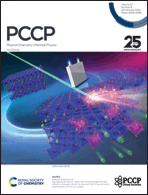 |
 |
||
| Elucidation of the Co4+ state with strong charge-transfer effects in charged LiCoO2 by resonant soft X-ray emission spectroscopy at the Co L3 edge
Daisuke Asakura, Takaaki Sudayama, Yusuke Nanba, Eiji Hosono, Hisao Kiuchi, Kosuke Yamazoe, Jun Miyawaki, Yoshihisa Harada, Atsuo Yamada, Ru-Pan Wang and Frank M. F. de Groot Phys. Chem. Chem. Phys., 2025, 27, 4092 DOI:10.1039/D4CP03759F |
Urea hydrogen-bond donor strengths: bigger is not always better
Celine Nieuwland, Angelina N. van Dam, F. Matthias Bickelhaupt and Célia Fonseca Guerra Phys. Chem. Chem. Phys., 2025, 27, 4099 DOI:10.1039/D4CP04042B |
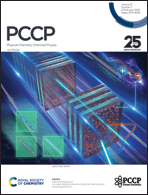 |
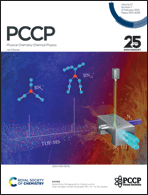 |
||
| An angle-selective photonic crystal for multi-physical sensing applications
Na Pei, Bao-Fei Wan, Hao-Cheng Ma, Ting-Hao Zhang, Sen Hong and Hai-Feng Zhang Phys. Chem. Chem. Phys., 2025, 27, 3558 DOI:10.1039/D4CP03468F |
High-nitrogen-content energetic BNn+ (n = 4–16) clusters
Jiale Li, Meicheng Chen, Kaiwen Liu, Kewei Ding, Hongguang Xu, Weijun Zheng and Cheng Lu Phys. Chem. Chem. Phys., 2025, 27, 3567 DOI:10.1039/D4CP03566F |
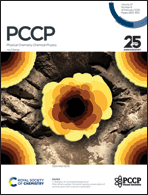 |
 |
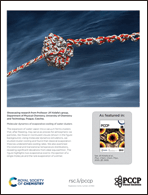 |
 |
| Flow-driven pattern formation during coacervation of xanthan gum with a cationic surfactant
Y. Stergiou, A. Perrakis, A. De Wit and K. Schwarzenberger Phys. Chem. Chem. Phys., 2025, 27, 2920 DOI:10.1039/D4CP01055H |
Controlling orbital ordering of intergrowth structures with flat [Ag(II)F2] layers to mimic oxocuprates(II)
Daniel Jezierski, José Lorenzana and Wojciech Grochala Phys. Chem. Chem. Phys., 2025, 27, 2927 DOI:10.1039/D4CP04145C |
Molecular dynamics of evaporative cooling of water clusters
Martin Klíma, Jiří Janek and Jiří Kolafa Phys. Chem. Chem. Phys., 2025, 27, 2939 DOI:10.1039/D4CP03980G |
Unveiling the molecular mechanism of Mn and Zn-catalyzed Ullmann-type C–O cross-coupling reactions
C. Rajalakshmi, Parvathi Santhoshkumar, Lydia Elizabeth Mathews, Ann Miriam Abraham, K. R. Rohit, Gopinathan Anilkumar and Vibin Ipe Thomas Phys. Chem. Chem. Phys., 2025, 27, 2948 DOI:10.1039/D4CP02777A |
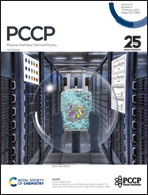 |
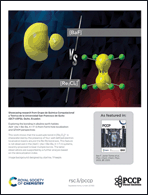 |
||
| Molecular dynamics as an efficient process to predict 15N chemical shift anisotropy at very high NMR magnetic fields
Maggy Hologne, Po-Chia Chen, François-Xavier Cantrelle and Olivier Walker Phys. Chem. Chem. Phys., 2025, 27, 2320 DOI:10.1039/D4CP03821E |
Exploring the bonding in alkaline earth halides AeX− (Ae = Be–Ba, X = F–I) from Fermi hole localization and QTAIM perspectives
Luis Rincon, Valeria Bedoya, Luis E. Seijas, Vladimir Rodríguez, Cesar Zambrano and F. Javier Torres Phys. Chem. Chem. Phys., 2025, 27, 2333 DOI:10.1039/D4CP04332D |
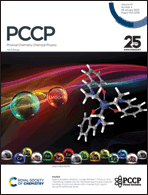 |
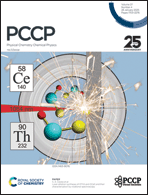 |
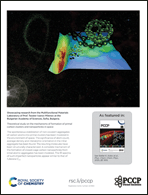 |
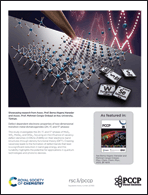 |
| Theoretical insights into the vibrational spectra and chemical bonding of Ln(III) complexes with a tripodal N4O3 ligand along the lanthanide series
Francielle C. Machado, Mateus Quintano, Carlos V. Santos-Jr, Albano N. Carneiro Neto, Elfi Kraka, Ricardo L. Longo and Renaldo T. Moura Jr. Phys. Chem. Chem. Phys., 2025, 27, 1794 DOI:10.1039/D4CP03677H |
Laser ablation syntheses of OThS and OCeS and their characterization by rotational spectroscopy
Joshua E. Isert, Alexander R. Davies, G. S. Grubbs II and S. A. Cooke Phys. Chem. Chem. Phys., 2025, 27, 1804 DOI:10.1039/D4CP04382K |
Theoretical study on the mechanisms of formation of primal carbon clusters and nanoparticles in space
Dobromir A. Kalchevski, Dimitar V. Trifonov, Stefan K. Kolev, Valentin N. Popov, Hristiyan A. Aleksandrov and Teodor I. Milenov Phys. Chem. Chem. Phys., 2025, 27, 1819 DOI:10.1039/D4CP02865A |
Defect dependent electronic properties of two-dimensional transition metal dichalcogenides (2H, 1T, and 1T′ phases)
Berna Akgenc Hanedar and Mehmet Cengiz Onbaşlı Phys. Chem. Chem. Phys., 2025, 27, 1809 DOI:10.1039/D4CP04017A |
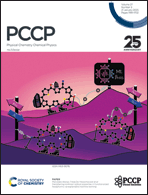 |
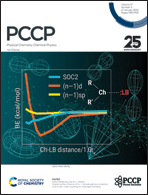 |
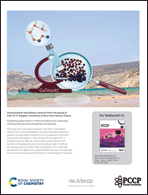 |
 |
| Deciphering nonlinear optical properties in functionalized hexaphyrins via explainable machine learning
Eline Desmedt, Michiel Jacobs, Mercedes Alonso and Freija De Vleeschouwer Phys. Chem. Chem. Phys., 2025, 27, 1256 DOI:10.1039/D4CP03303E |
Exploring the influence of (n − 1)d subvalence correlation and of spin–orbit coupling on chalcogen bonding
Nisha Mehta and Jan M. L. Martin Phys. Chem. Chem. Phys., 2025, 27, 1274 DOI:10.1039/D4CP01877J |
Exploiting graph theory in MD simulations for extracting chemical and physical properties of materials
Sana Bougueroua, Alexander A. Kolganov, Chloé Helain, Coralie Zens, Dominique Barth, Evgeny A. Pidko and Marie-Pierre Gaigeot Phys. Chem. Chem. Phys., 2025, 27, 1298 DOI:10.1039/D4CP02764G |
Enhancing the electronic and photocatalytic properties of (SnO2)n/(TiO2)m oxide superlattices for efficient hydrogen production: a first-principles study
Najwa Harrati, Bastien Casier and Adlane Sayede Phys. Chem. Chem. Phys., 2025, 27, 1284 DOI:10.1039/D4CP03363A |
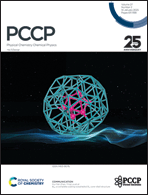 |
|||
| B92: a complete coating icosahedral B12 core–shell structure
Yi-Sha Chen, Jing-Jing Guo, Peng-Bo Liu, Hui-Yan Zhao, Jing Wang and Ying Liu Phys. Chem. Chem. Phys., 2025, 27, 655 DOI:10.1039/D4CP03471F |
 |
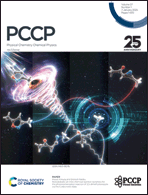 |
 |
|
| Intermolecular interaction potential maps from energy decomposition for interpreting reactivity and intermolecular interactions
Amin Kiani, Wentong Zhou and Lawrence M. Wolf Phys. Chem. Chem. Phys., 2025, 27, 47 DOI:10.1039/D4CP03237C |
Nonadiabatic ab initio chemical reaction dynamics for the photoisomerization reaction of 3,5-dimethylisoxazole via the S1 electronic state
Mizuki Kimura and Shinkoh Nanbu Phys. Chem. Chem. Phys., 2025, 27, 62 DOI:10.1039/D4CP03137G |
Inversion of circularly polarized luminescence by electric current flow during transition
Ayumi Imayoshi, Shinya Fujio, Yuuki Nagaya, Misato Sakai, Atsushi Terazawa, Misa Sakura, Keita Okada, Takahiro Kimoto, Tadashi Mori, Yoshitane Imai, Masahiko Hada and Kazunori Tsubaki Phys. Chem. Chem. Phys., 2025, 27, 77 DOI:10.1039/D4CP02968B |
















